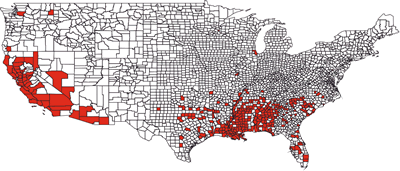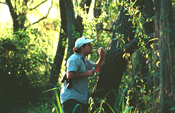Success of Introduced Argentine Ants Tied to Reduced Genetic Variation
MAY 15, 2000
By Kim McDonald
Biologists at the University of California, San Diego have discovered that the proliferation in California of the introduced Argentine ant, a major pest that has invaded homes and displaced native species of ants in much of the coastal regions of the state, is due to the lack of genetic diversity among individuals up and down the coast.
In paper published in the May 16 issue of the Proceedings of the National Academy of Sciences, the scientists conclude that this reduced genetic variation has essentially allowed a giant "supercolony" of closely related ants to grow unchecked from San Diego to Ukiah, 100 miles north of San Francisco. In Argentina, by contrast, fighting among the more genetically dissimilar, territorial ants has managed to keep these insects in check and in smaller, much more sharply defined colonies than those in California.
"When we did our field work in Argentina, it was surprisingly difficult to find Argentine ants, compared to our experience in California," says Ted J. Case, a professor of biology at UCSD who headed the research team. "They are a relatively inconspicuous feature, both in the urban and in the natural environment."
Not so in California, particularly in the southern part of the state, where the ant is regarded as the number one pest extermination companies are called upon to remove from people’s homes. "If you live in urban San Diego or Los Angeles, this is the ant that’s in your house and is invading your garden and office," says Neil D. Tsutsui, a graduate student and the first author of the study.

Areas infested by Argentine ants in red
The tiny dark-brown and black ants, which are about two millimeters in length, are thought to have entered the United States aboard ships carrying coffee or sugar from Argentina during the 1890s, then expanded throughout California and the southern parts of the United States. In the Southeast and much of the South, their proliferation is now limited to some extent by the introduction of fire ants.
But in California, where those competitors are largely absent, the ants thrive in the temperate and damp coastal regions, killing and displacing native ants, many of which are 10 times larger in size. "The striking thing about Argentine ants in California is that as long as the habitat is favorable, they completely dominate," says David A. Holway, a postdoctoral researcher at UCSD and a co-author of the paper.
Their growth has not only been a problem for native ant species, but for species that feed on the larger native ants. One such creature is the coastal horned lizard, which has declined by 50 percent in recent years, according to Andrew V. Suarez, a graduate student and a co-author of the paper who has been studying the impact of the introduced ants on the lizards.
 He discovered two years ago that native Argentine ant colonies living in close proximity were territorial and aggressive toward one another, literally tearing one another apart whenever they came into contact. The puzzling question to the researchers was, Why weren’t the introduced ants in California the same way? Why would an Argentine ant from San Diego dropped into a colony in San Francisco be welcomed, while an Argentine ant dropped into a colony two hundred meters away in its native country be torn apart?
He discovered two years ago that native Argentine ant colonies living in close proximity were territorial and aggressive toward one another, literally tearing one another apart whenever they came into contact. The puzzling question to the researchers was, Why weren’t the introduced ants in California the same way? Why would an Argentine ant from San Diego dropped into a colony in San Francisco be welcomed, while an Argentine ant dropped into a colony two hundred meters away in its native country be torn apart?
Tsutsui set out to answer that question by comparing the genetic differences among the ants in Argentina with those in various parts of California, from San Diego to Ukiah. Using some of the same DNA fingerprinting techniques employed by criminologists, he discovered that the native Argentine ants were twice as diverse as the native California ants, explaining why the California ants regard individuals up and down the coast as close kin, while those different nearby colonies in Argentina do not.
"They have an innate ability to recognize other members of their colony based on how genetically similar they are to themselves," says Tsutsui. "Since they evolved in their native range, where colonies are set up as family structures, they tend to recognize other members of their colony by how closely related they are."
Tsutsui and his colleagues conclude that the low genetic diversity among the California ants is the result of the introduced ants having gone through a "genetic bottleneck." In other words, the genes are similar among California ants because they are descended from a relatively small founding population of genetically similar ants from one single or closely related colonies in Argentina.
"Because they’ve gone through a genetic bottleneck, everybody’s genetically similar and everybody recognizes everybody else as a member of their own colony," says Tsutsui. "In essence, the supercolony that we see in California is in fact one big colony."
"The thing that’s surprising about this result is that, typically, reduced genetic variation or diversity are considered bad for populations," he adds. "With Argentine ants, it really looks like this is beneficial for the species, at least for the short term."
The UCSD researchers are extending their investigations to other parts of the United States and the world where Argentine ants have been introduced to determine if the genetic similarities found in California are found in other regions and are typical of other introduced populations that have been expanding rapidly. They also hope to examine whether genetic bottlenecks are a common phenomenon in the introduction and success of other invasive ant species. Their study was financed by the Canon National Parks Science Scholars Program, the National Science Foundation and the U.S. Department of Agriculture.
Photo 1: An Argentine ant worker, shown on a pencil for scale. Credit: Andrew Suarez, UCSD.
Photo 2: Andrew Suarez collecting native ants in Argentina. Credit: Neil Tsutsui, UCSD.
